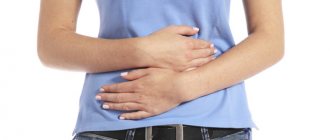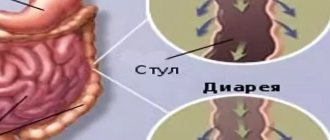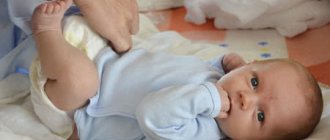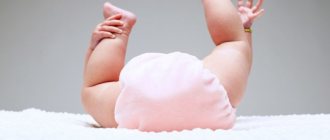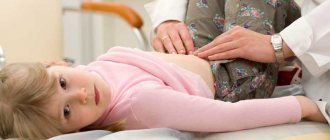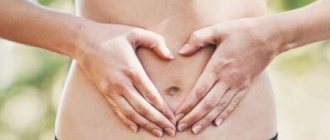The difference between diarrhea and loose stools in infants
During breastfeeding, liquid stool consistency is considered normal for babies. This is due to the consumption of large amounts of fatty, nutritious milk.
Normally, the structure of stool looks mushy and watery. The color ranges from light brown to yellow. The number of bowel movements may vary, but according to medical studies, the norm is 3-5 times. Allowed up to 10 times. The main thing is that the process does not cause pain and crying in the child.
In infants fed artificial milk, stool has differences in consistency and color. It is denser and browner, and may contain inclusions of white lumps. The smell is pungent and unpleasant. The frequency of bowel movements is 2-5 times.
The following signs will help identify diarrhea in infants:
- increased frequency of bowel movements;
- the appearance of water, foam, blood impurities in the stool;
- change in odor to a distinctly sour or putrid odor;
- loss of appetite, weight loss;
- the release of feces is accompanied by a rumbling stomach and occurs abruptly;
- increased gas formation and colic are observed;
- increase in body temperature.
Establishing at least one symptom requires consultation with a doctor.
Dangerous manifestations of intestinal disorder
In an infant, even minor changes in condition are manifested in changes in stool, ranging from reduced immunity to a reaction to the introduction of new complementary foods during feeding. Diarrhea can also begin due to nervous disorders and teething.
The danger lies in the fact that disruption of the gastric microflora during diarrhea leads to the rejection of beneficial substances by the newborn’s body.
Whatever the reason for loose stools, it is necessary to intensively replenish the loss of fluid in the body of children, and treatment of the infant should be started as soon as possible.
What does stool look like with diarrhea and normally?
Diarrhea in a newborn who is breastfed or formula-fed is a normal reaction to changes in diet or exposure to external negative factors. It is difficult to recognize; loose stools are normal for babies due to the consumption of liquid milk and water. Density is acquired as they grow older, when complementary feeding of purees, soups, and other dishes begins. Only a one-year-old baby has fully formed feces, like an adult.
A one-month-old baby defecates frequently and loosely. Feces have a milky, sour odor and their color ranges from bright yellow to brown. Feeding with artificial formulas makes the discharge green and unpleasant in smell. Undigested white lumps may occur.
After 6 months, the infant goes to the toilet with a thicker and darker mass. The frequency of bowel movements can reach up to 6-7 times a day. If stool is less frequent, this is a sign of good digestibility of milk and is not a pathology if the child is feeling normal.
With such indicators, diarrhea in a breastfed or bottle-fed baby can only be recognized by comparison with the norm:
| Basic indicators | Normal stool | Diarrhea |
| Stool coloring | Dark yellow, golden, light or dark brown. | Brown, yellow, white, black, red, maroon, green. |
| Structure | Similar to mush. | Mushy or liquefied. |
| Number of bowel movements per day | 1-8 times (up to 10 is acceptable). | More than 8 times or higher for a particular child. |
| Impurities | A small amount of white lumps and mucus. | Pieces of undigested food, green specks, blood, a large amount of mucus, water. |
| Character of bowel movements | Decorated, uniform. | Foamy, with water, unformed, in separate parts. |
| Smell | Unpleasantly sour or mixture-specific. | There is no smell at all or it is fetid, putrefactive, as during fermentation of foods. |
A change in consistency may indicate a dangerous pathology. Green stool is a symptom of dysbiosis or a serious intestinal infection that requires immediate medical attention. Stopping cleansing yourself when infected with pathogenic microorganisms is dangerous. This threatens severe intoxication with waste products of pests and dehydration.
Diarrhea is a sign of dangerous diseases
When diarrhea is accompanied by vomiting, body temperature rises above 38 degrees, colic appears, these are symptoms of the presence of infection in the body.
The appearance of foam in the stool is a dangerous sign; the baby lacks useful microelements; this can occur due to improper use of antibiotics.
E. coli contributes to an increase in temperature, constant bowel movements, watery stools, vomiting, and the newborn’s abdomen swells and becomes hard to the touch.
Blood in the stool indicates the appearance of infectious bacteria in the intestines; such symptoms can indicate very dangerous diseases, dysentery and salmonellosis.
Diagnostic methods
The doctor will examine the baby and may prescribe bacterial stool cultures , blood tests, and tests for dysbacteriosis. The results can confirm or refute the diagnosis.
Dysbacteriosis can only be detected by a special analysis. The same applies to lactase deficiency, which neither the mother nor the doctor can detect by eye. If the baby has an intestinal infection, tests will show an increased content of fat and leukocytes.
Constipation in a breastfed child Komarovsky
The famous pediatrician Dr. Komarovsky describes constipation in children as irregular, untimely or difficult bowel movements. In the latter case, the process of defecation gives the baby quite unpleasant, sometimes even painful sensations. And if the child does not poop on time, colic begins to bother him. gases, bloating and other troubles. The baby may not have a bowel movement every day. It is important to monitor his condition. If the child is breastfed and walks “largely” once every 1-3 days, and is cheerful, cheerful, and feels good, there is no need to panic. This means that mother’s milk is suitable for him and is completely digestible. But if you notice painful constipation in your baby. Komarovsky strongly advises taking action immediately.
Komarovsky defines constipation in newborns as rare cases of bowel movements that cause poor health and discomfort.
Often, inexperienced parents begin to sound the alarm if they do not like the consistency, color, or appearance of the baby's stool. But the pediatrician insists that the child is breastfed. may have completely different indicators. And this is not a problem if he is gaining weight and developing normally. Komarovsky comments on constipation in the video in this way: constipation cannot be the only symptom of the disease; if it is present, it will be expressed in other signs. You should definitely be alert to a bloated stomach, behavioral disturbances, and difficulty swallowing. You should start fussing when the child does not poop and feels unwell. In other cases, wait patiently until everything happens by itself.
If your baby still has constipation, Komarovsky advises, first of all, to review the diet of the mother if she is breastfeeding, and of the child if he is already receiving complementary foods. Some foods may be difficult to digest
Source
Doctor Komarovsky advises
The absence of fever is a positive factor, which means that pathogenic bacteria are not present, and diarrhea is caused by a reaction to normal physiological processes during teething or a change in diet.
Dr. Komarovsky advises not to panic in such cases, but to urgently take measures to restore the water-salt balance in the body.
In the intestines of children, like adults, special mucus is produced; this mucus performs a protective function, preventing the negative effects of pathogenic microorganisms and toxins, which are found in sufficient quantities in the surrounding atmosphere.
Any viruses that enter the body destroy the process of formation of beneficial mucus by cells; the destruction of mucus leads to the formation of unprotected areas in the intestinal wall; toxic substances released by harmful bacteria enter these unprotected areas.
When the walls of the stomach are irritated by toxins, a large amount of fluid begins to be produced, which is how the inflammatory process begins, which causes prolonged diarrhea.
Dr. Komarovsky recommends taking large amounts of liquid with beneficial microelements in order to restore the baby’s water and electrolyte balance.
First medical aid is the restoration of the gastric mucosa.
Infection with intestinal infections
The baby is especially susceptible to harmful microbes, such as E. coli, dysentery, salmonella, and typhoid bacilli.
Intestinal infections often occur in children under one year of age; this is very dangerous; the disease can interfere with the normal formation of important functions and have consequences for the development of the entire organism.
Signs of intestinal infections are:
- constant vomiting;
- diarrhea;
- temperature increase;
- the skin changes its natural color, the child becomes pale;
- gas formation increases;
- the baby refuses to eat.
With such symptoms, urgent hospitalization is required; small children find it difficult to tolerate infectious diseases without professional intervention; treatment at home is impossible.
To urgently alleviate the baby’s condition and prevent negative consequences, before the doctor arrives, you should take medications like Regidron; it will reduce the effect of pathogenic bacteria, help the baby’s body fight infection and replenish the water-salt balance in the body.
Special instructions and recommendations for parents
Please note that it is not the diarrhea itself that is treated, but its cause . Parents should not act without the supervision of a specialist. He must establish the cause, and then prescribe therapeutic measures.
For acute intestinal infections, additional examinations are usually prescribed. Possible hospitalization.
For bacterial infections, antibiotics, probiotics and prebiotics are prescribed to be taken together.
Antibacterial drugs are ineffective for rotavirus infection.
Separately, it is worth mentioning malabsorption - intolerance to enzymes in food and the inability to absorb them.
There are two types of it:
- Lactase deficiency. This milk intolerance makes itself felt from the first days of a baby’s life. The stool may have a green tint and foam may be visible. Manifested by vomiting and colic. In this case, the child is transferred to a lactose-free diet, and usually his condition returns to normal within a month.
- Celiac disease.
A disease associated with damage to the small intestine. The body is not able to digest grains: oats, wheat, rye. Mothers learn about this when these products are introduced into the diet. The stool will be frequent, and you will notice foam and an oily sheen on it. To restore a normal state, it is usually enough to exclude grains from the diet.
If the baby is on mixed feeding, you need to take into account that the protein in the mixtures is foreign, for example, from soy or cow's milk. This is much less beneficial for babies than breast milk.
Possible disruption of lactase production, allergic inflammation of the stomach. There may be no external symptoms, but in the intestines there may be malabsorption of a number of components. Therefore, if a baby is on mixed feeding and has been experiencing diarrhea for too long, it makes sense to undergo testing for allergens.
Possible complications
Treatment for the disorder involves more than just stopping the diarrhea. It is necessary to replenish the newborn's water balance. Along with the fluid, beneficial salts leave the body. A terrible consequence is dehydration. The condition has signs:
- Rare urination with dark-colored urine;
- Severe weight loss – 5% of body weight;
- Crying without tears, dry lips;
- Paleness of the skin;
- The baby appears lethargic.
At the first sign of a complication, call a doctor. Before the health worker arrives, give the child clean boiled water and apply it to the breast more often.
Teething
Diarrhea can occur during teething in children, and an increase in temperature is also a concomitant phenomenon.
This is a rather painful process, but it does not pose a danger to babies. In many children under one year of age, when teething, diarrhea begins and the temperature rises; a feverish state may appear; the symptoms that appear must be treated.
This is due to the fact that when teething occurs, the baby’s immunity is greatly reduced. The child is worried, he is uncomfortable, everything that comes to hand goes into his mouth. It is no wonder that any pathogenic bacteria easily enters the body.
Also, when teething, babies under one year old experience abundant salivation, which also leads to more frequent and loose stools.
No specific treatment is required in this case:
- try to alleviate the baby’s condition with the help of special cooling gels;
- replenish fluid lost by the body to avoid dehydration;
- try to limit visits to crowded places so that another infection does not occur.
You can check whether frequent bowel movements and elevated temperature are associated with the appearance of teeth by looking at the condition of the baby’s gums. Even before the first teeth appear, the gums swell and a lump appears - this is a completely normal factor, there is no reason for concern.
Usually, when teething, diarrhea does not last long. The body adapts within a few days.
If this problem persists for a longer period of time, you see that the baby is getting worse, there is no positive dynamics, consult a doctor immediately. Perhaps the baby needs to be treated in a hospital setting.
There is a tendency to attribute any ailment in a child under one year of age during teething to these physiological changes in the body. This should not be done under any circumstances; it is better to play it safe and show the baby to a pediatrician.

